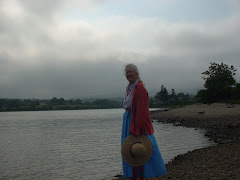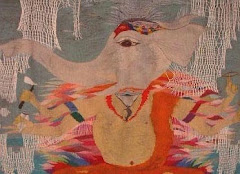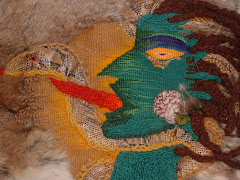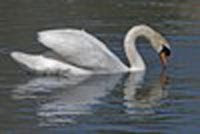Chapter Two
December 26, 2004.
Near Amritapuri Ashram in India, by the narrow pennisula that separates the Arabian Sea from the brackish backwater river, a lone, pole-driven canoe carrying a European couple on a pleasure ride, glides along the backwaters. Jungle birds whistle in the coconut palm forest. On the opposite shore we wait in the hot sun for the small motor ferry to carry us across to the ashram. The pleasure canoe drifts alongside the ashram boat jetty and moors; the man helps the woman step out, and they stroll away.
Seconds later, dark gray water surges through gullies, shoots into the backwaters, capsizing the pleasure canoe and dumping debris in its wake. A village fisherman shouts, waving his arms. Many Sunday visitors who’d been waiting for the motor ferry, run away. I’m transfixed. Where is all that water coming from and why? Then it dawns on me.
“Was that a tsunami?” I ask Indian man in his Sunday best.
He’s walking away, slowly, head down. “Yes.”
“We better get to high ground,” I say to him and my friend, “I think another wave is coming.” We head down the pathway to the ashram’s four-story computer school, five minutes away. A group of students saunter along in front of us. “We need to move quickly,” I say, all the while imagining giant waves from movies I’ve seen.
Meanwhile, on the peninsula across the backwaters, minutes from the ashram complex, the Arabian Sea waters have receded to about forty feet beyond the average tidal mark. Visitors, ashram residents, and villagers delight in the strange phenomena, the exposed expanse of beach. A messenger comes running—“Quick. Get away. Run to the ashram. Go up to the second and third floors.” The ashram’s PA system blares, an announcement in eighteen languages for everyone to climb to the upper stories of the temple building or ashram flats, and for visitors to move the few cars parked by the ocean. 10,000 guests had gathered for a special Sunday program, and another 4,000 Indian and Western ashram residents had been engaged in their daily routines.
We wait for what becomes known as “the killer wave.”
Fear of natural disaster festers in the recesses of the unconscious mind in most human beings the world over. Beginning with the flood of Noah, told about in scriptures from cultures all over the world—Vedic, South American, Sumerian, and Biblical—our ancestors have known the threat of deluge. The memory, passed down, lives within us all. Throughout the ages, again and again, the winds and the rains rise and whip the waters, uproot trees, batter homes. Like an erupting geyser the archetypal emotion of fear surges out of the depths of its hiding place. We have little recourse over wrath of sea and sky. Scientists cannot stop it; they can only notice the signs and even then, might not know. In the old days, soothsayers and astrologers often predicted calamities, but even they were limited.
You and I—suddenly there we are, standing alone in raw emotion with only instinct to guide us. Fear on the most fundamental level is a primal urge to survive. As with animals, most of us will run or find shelter from fire, volcano, typhoon, and wave. And, as with animals, some of us will have the impulse to save others along the way. A friend of mine told of a fire from a propane tank that had exploded inside a festival’s kitchen tent. Scores of people were racing away from the raging heat. But not my friend. He tore into the flaming tent where he crawled on the ground under the smoke and found a woman lying there, burning. He carried her to safety. He had no other explanation for his act, than that he was compelled. He had no forethought, no plan, only an inner impulse that drove him into, rather than away from, the fire.
Here’s another kind of primal fear: Who can we trust in calamity or in calm? The same question was posed thousands of years ago in the parable of Cain and Abel, the children of Adam and Eve. After Cain murders his brother Abel, God asks, “Where is your brother?” To which Cain answers, “I do not know… Am I my brother’s keeper?” Throughout the ages, fear of loss or fear of being lesser-than, drives some people to lesser deeds. Some cannot be counted on; tales of intrigue abound in most governments, as do plots among brothers and sisters niggling over inheritances. What do you do when you can’t trust family members or friends or colleagues? Some will be inclined like Abel, to live in harmony at all costs, and some will be disposed like Cain, to do the unspeakable.
A mother tells her child,
“When you’re walking through the graveyard at night
and you see a boogeyman, run at it,
and it will go away.”
“But what” the replies the child, “if the boogeyman’s
mother has told it to do the same thing?
Boogeymen have mothers too.”
--Rumi
Do stories of natural disaster and personal drama—old and new—indicate that we must live in fear?
Maybe not.
In the aftermath of the Asian tsunami, a few people took advantage and looted, and thousands rallied to help--to feed the living, to collect and cremate the dead, to offer medical relief, to rebuild homes and boats, to inspire and give hope for the future.
But still the question of fear and how to live with it persists.
I’ve heard some say fear ought to be eradicated from the array of human emotions, or that cultivating fear’s opposite, which some theorize is love, is the only balm.
Looking at the two poles can be revealing: Experience tells me that fear contains its own apparent opposites. On the other end of terror that erupts in the face of natural disaster, is the hair-raising experience of divine awe. Imagine it. If in the face of blazing fire or giant wave, we are shaken to the core, what about face to face encounters with stunning beauty? At Niagara Falls I step out of the comfort of my car, into the roar and power of water, engulfed. At the Grand Canyon’s North Rim, I head down the trail, smelling the spruce along the way, and suddenly there I am at the edge a great gaping chasm, vast, with endless layers of earth, exposed.
Remember the Biblical tale of Moses trembling in front of the burning bush—“‘Put off your sandals from your feet, for the place on which you stand is holy ground’…and Moses concealed his face, for he was afraid to gaze upon God.” In The Bhagavad Gita, Arjuna asks Krishna to reveal his cosmic form. Upon witnessing the blazing vision, Arjuna says: “On seeing Thee, touching the sky, shining in many colors, with mouths wide open, with large fiery eyes, I am terrified at heart and find neither courage nor peace.”
How different are the experiences of divine awe, really, than the sight of an encroaching volcanic lava flow or tsunami wave? Think of it. The universe burst forth out of the greatest natural disaster of all—the big bang. Stars explode into their brilliance out of nuclear combustion; the Eagle Nebula, the Orion Nebula—stellar nurseries.
How to let fear be an ally.
Fear has the potential to lead us to something inside of ourselves that is quite marvelous, a connection to creation itself. Getting in touch with terror and ill ease can allow us to uncover our creative power, to live more freely and with a sense of love and joy pervading all things.
What can we do when many aspects of life—the behaviors of Mother Nature and people— lie beyond our control and seem to threaten? How can we settle in with fear?
The exercise below can help you tune in to feelings of alarm and trepidation, and at the same time help you avoid living with fear. Because going about your day in a state of constant worry is debilitating; it cuts off the flow of life breath and creativity; it stops your vital energy.
Preparation for the fear exercise: Sit down in a quiet place and get in touch with the power of your inner self by practicing the breathing meditation described at the end of the first post (See archive: "Preparing for the unforeseen: Overview"). As you practice the exercise below, notice the ways fear can be a useful emotion in daily life; through the breathing meditation and the fear exercise you can learn to discern the presence of actual danger from imagined threat. You can develop valuable intuition.
Only a person who leads a moment-to-moment life can be completely free from fear... This moment-to-moment living is possible only through meditation and doing spiritual practices.
--Amma
Fear exercise:
First, when you notice a persistent fear around certain aspects of daily living, or an old dread or horror that rises up inside of you, sit with the feeling, close your eyes and breathe into the feeling.
Second. as a sense of peace comes over you, feel the fear as pure energy. Feel the power of it. Feel the love in it. Feel its connection to creation itself. Sit with the feeling.
Third, have writing materials and/or artist materials ready. Write about your experiences and/or draw them.
Fourth, share your experiences with a trusted friend who also practices the fear exercise.
This being human is a guest house.
Every morning a new arrival.
A joy, a depression, a meanness,
some momentary awareness comes
as an unexpected visitor.
Welcome and entertain them all!
Even if they’re a crowd of sorrows,
who violently sweep your house
empty of its furniture,
still, treat each guest honorably.
He may be clearing you out
for some new delight.
The dark thought, the shame, the malice,
meet them at the door laughing,
and invite them in.
Be grateful for whoever comes,
because each has been sent
as a guide from beyond.
—Rumi
Seconds later, dark gray water surges through gullies, shoots into the backwaters, capsizing the pleasure canoe and dumping debris in its wake. A village fisherman shouts, waving his arms. Many Sunday visitors who’d been waiting for the motor ferry, run away. I’m transfixed. Where is all that water coming from and why? Then it dawns on me.
“Was that a tsunami?” I ask Indian man in his Sunday best.
He’s walking away, slowly, head down. “Yes.”
“We better get to high ground,” I say to him and my friend, “I think another wave is coming.” We head down the pathway to the ashram’s four-story computer school, five minutes away. A group of students saunter along in front of us. “We need to move quickly,” I say, all the while imagining giant waves from movies I’ve seen.
Meanwhile, on the peninsula across the backwaters, minutes from the ashram complex, the Arabian Sea waters have receded to about forty feet beyond the average tidal mark. Visitors, ashram residents, and villagers delight in the strange phenomena, the exposed expanse of beach. A messenger comes running—“Quick. Get away. Run to the ashram. Go up to the second and third floors.” The ashram’s PA system blares, an announcement in eighteen languages for everyone to climb to the upper stories of the temple building or ashram flats, and for visitors to move the few cars parked by the ocean. 10,000 guests had gathered for a special Sunday program, and another 4,000 Indian and Western ashram residents had been engaged in their daily routines.
We wait for what becomes known as “the killer wave.”
Fear of natural disaster festers in the recesses of the unconscious mind in most human beings the world over. Beginning with the flood of Noah, told about in scriptures from cultures all over the world—Vedic, South American, Sumerian, and Biblical—our ancestors have known the threat of deluge. The memory, passed down, lives within us all. Throughout the ages, again and again, the winds and the rains rise and whip the waters, uproot trees, batter homes. Like an erupting geyser the archetypal emotion of fear surges out of the depths of its hiding place. We have little recourse over wrath of sea and sky. Scientists cannot stop it; they can only notice the signs and even then, might not know. In the old days, soothsayers and astrologers often predicted calamities, but even they were limited.
You and I—suddenly there we are, standing alone in raw emotion with only instinct to guide us. Fear on the most fundamental level is a primal urge to survive. As with animals, most of us will run or find shelter from fire, volcano, typhoon, and wave. And, as with animals, some of us will have the impulse to save others along the way. A friend of mine told of a fire from a propane tank that had exploded inside a festival’s kitchen tent. Scores of people were racing away from the raging heat. But not my friend. He tore into the flaming tent where he crawled on the ground under the smoke and found a woman lying there, burning. He carried her to safety. He had no other explanation for his act, than that he was compelled. He had no forethought, no plan, only an inner impulse that drove him into, rather than away from, the fire.
Here’s another kind of primal fear: Who can we trust in calamity or in calm? The same question was posed thousands of years ago in the parable of Cain and Abel, the children of Adam and Eve. After Cain murders his brother Abel, God asks, “Where is your brother?” To which Cain answers, “I do not know… Am I my brother’s keeper?” Throughout the ages, fear of loss or fear of being lesser-than, drives some people to lesser deeds. Some cannot be counted on; tales of intrigue abound in most governments, as do plots among brothers and sisters niggling over inheritances. What do you do when you can’t trust family members or friends or colleagues? Some will be inclined like Abel, to live in harmony at all costs, and some will be disposed like Cain, to do the unspeakable.
A mother tells her child,
“When you’re walking through the graveyard at night
and you see a boogeyman, run at it,
and it will go away.”
“But what” the replies the child, “if the boogeyman’s
mother has told it to do the same thing?
Boogeymen have mothers too.”
--Rumi
Do stories of natural disaster and personal drama—old and new—indicate that we must live in fear?
Maybe not.
In the aftermath of the Asian tsunami, a few people took advantage and looted, and thousands rallied to help--to feed the living, to collect and cremate the dead, to offer medical relief, to rebuild homes and boats, to inspire and give hope for the future.
But still the question of fear and how to live with it persists.
I’ve heard some say fear ought to be eradicated from the array of human emotions, or that cultivating fear’s opposite, which some theorize is love, is the only balm.
Looking at the two poles can be revealing: Experience tells me that fear contains its own apparent opposites. On the other end of terror that erupts in the face of natural disaster, is the hair-raising experience of divine awe. Imagine it. If in the face of blazing fire or giant wave, we are shaken to the core, what about face to face encounters with stunning beauty? At Niagara Falls I step out of the comfort of my car, into the roar and power of water, engulfed. At the Grand Canyon’s North Rim, I head down the trail, smelling the spruce along the way, and suddenly there I am at the edge a great gaping chasm, vast, with endless layers of earth, exposed.
Remember the Biblical tale of Moses trembling in front of the burning bush—“‘Put off your sandals from your feet, for the place on which you stand is holy ground’…and Moses concealed his face, for he was afraid to gaze upon God.” In The Bhagavad Gita, Arjuna asks Krishna to reveal his cosmic form. Upon witnessing the blazing vision, Arjuna says: “On seeing Thee, touching the sky, shining in many colors, with mouths wide open, with large fiery eyes, I am terrified at heart and find neither courage nor peace.”
How different are the experiences of divine awe, really, than the sight of an encroaching volcanic lava flow or tsunami wave? Think of it. The universe burst forth out of the greatest natural disaster of all—the big bang. Stars explode into their brilliance out of nuclear combustion; the Eagle Nebula, the Orion Nebula—stellar nurseries.
How to let fear be an ally.
Fear has the potential to lead us to something inside of ourselves that is quite marvelous, a connection to creation itself. Getting in touch with terror and ill ease can allow us to uncover our creative power, to live more freely and with a sense of love and joy pervading all things.
What can we do when many aspects of life—the behaviors of Mother Nature and people— lie beyond our control and seem to threaten? How can we settle in with fear?
The exercise below can help you tune in to feelings of alarm and trepidation, and at the same time help you avoid living with fear. Because going about your day in a state of constant worry is debilitating; it cuts off the flow of life breath and creativity; it stops your vital energy.
Preparation for the fear exercise: Sit down in a quiet place and get in touch with the power of your inner self by practicing the breathing meditation described at the end of the first post (See archive: "Preparing for the unforeseen: Overview"). As you practice the exercise below, notice the ways fear can be a useful emotion in daily life; through the breathing meditation and the fear exercise you can learn to discern the presence of actual danger from imagined threat. You can develop valuable intuition.
Only a person who leads a moment-to-moment life can be completely free from fear... This moment-to-moment living is possible only through meditation and doing spiritual practices.
--Amma
Fear exercise:
First, when you notice a persistent fear around certain aspects of daily living, or an old dread or horror that rises up inside of you, sit with the feeling, close your eyes and breathe into the feeling.
Second. as a sense of peace comes over you, feel the fear as pure energy. Feel the power of it. Feel the love in it. Feel its connection to creation itself. Sit with the feeling.
Third, have writing materials and/or artist materials ready. Write about your experiences and/or draw them.
Fourth, share your experiences with a trusted friend who also practices the fear exercise.
This being human is a guest house.
Every morning a new arrival.
A joy, a depression, a meanness,
some momentary awareness comes
as an unexpected visitor.
Welcome and entertain them all!
Even if they’re a crowd of sorrows,
who violently sweep your house
empty of its furniture,
still, treat each guest honorably.
He may be clearing you out
for some new delight.
The dark thought, the shame, the malice,
meet them at the door laughing,
and invite them in.
Be grateful for whoever comes,
because each has been sent
as a guide from beyond.
—Rumi








3 comments:
I will be taking your workshop at USM.
When looking through the enrichment catalogue your workshop stood out to me. I am particularly interested in this fear section because it is a big part of my life right now.
I do not know how to breathe into a feeling. I am afraid that if I let fear be present it would stop me from moving forward.
Maybe some other people have this same feeling? This is why I am interested in learning how to let fear become a strength rather than an obstacle.
I look forward to your workshop.
Thanks for commenting. I believe your feelings about fear are shared by many. I'll look forward to meeting you at my workshop! I'll be showing you gentle and simple ways to breathe into feelings, including fear. Judging from my experience with myself and others, I think you will find a freedom in the breathing practice, and that your fear (and other difficult feelings) will relax and you will feel hopeful and will find yourself moving ahead in life with greater ease. Thanks again, Savitri
And...once ease is felt, I'll be showing you other practices that will help you uncover your inherent strengths underneath (or within) the fear.
Post a Comment